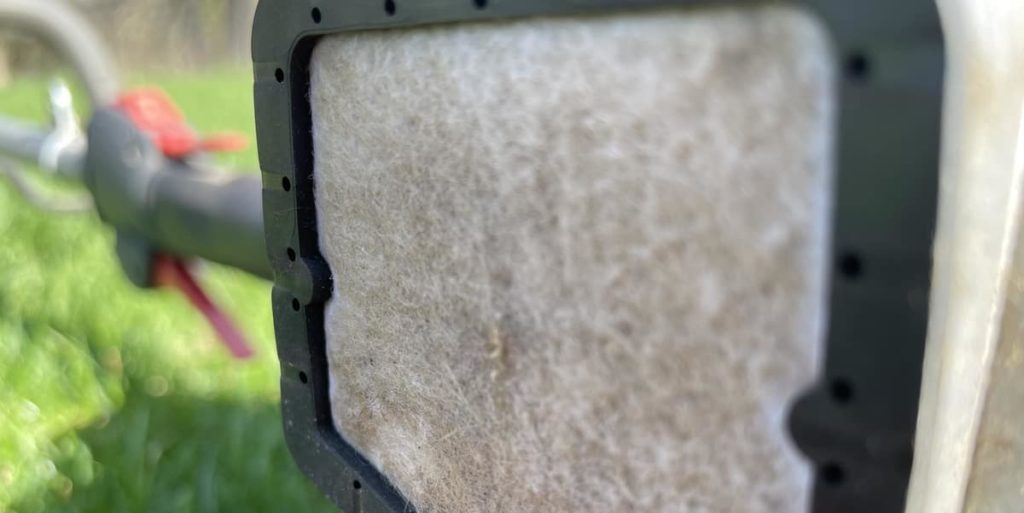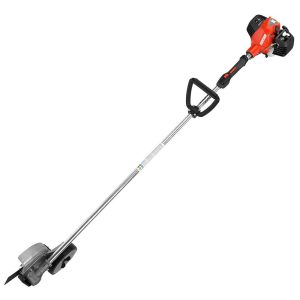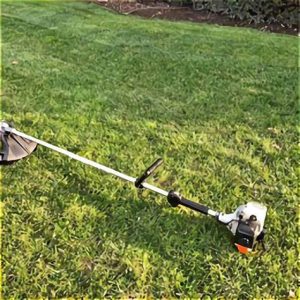Your Shindaiwa String Trimmer Has No Power: SOLVED!
You’re trying to trim with your string trimmer and find it’s not giving you the power you’re used to. Without this power, the trimmer can bog down and have a hard time cutting weeds. I’ll go over the most common reasons you’ll start experiencing a loss of power with your Shindaiwa string trimmer.
A Shindaiwa string trimmer will lose power when it doesn’t receive the fuel, air, or spark required to keep it running at its best. A loss of power may also be experienced with carbon buildup plugging the spark arrestor, exhaust port, and muffler.
Before performing any repairs on your string trimmer, remove the spark plug wire, wait for the engine to cool, and wait for all moving parts to stop.
Reasons a Shindaiwa string trimmer has no power:
- Old fuel
- Plugged air filter
- Dirty spark plug
- Plugged fuel filter
- Clogged fuel line
- Plugged fuel tank vent
- Plugged spark arrestor
- Carbon buildup on the exhaust port
- Dirty carburetor

This post may include affiliate links. Purchases made through these links may provide a commission for us, at no extra cost to you. As an Amazon Associate, we earn from qualifying purchases.
Follow all safety instructions provided in your equipment operator’s manual prior to diagnosing, repairing, or operating.Consult a professional if you don’t have the skills, or knowledge or are not in the condition to perform the repair safely.
Table of Contents
8 Reasons a Shindaiwa String Trimmer Has No Power
Old Gasoline Causes a Shindaiwa String Trimmer to Lose Power
Using old gas in your Shindaiwa can contribute to many problems in a string trimmer including the loss of power. Gas sitting longer than 30 days after purchase will begin to break down and become less effective.
Much of the gas sold today includes ethanol. Ethanol attracts water to the fuel system which leaves behind varnish and causes corrosion. This can have negative effects on the trimmer including fuel restrictions, component failures, and engine damage.
Because ethanol is harmful to the small engine on your Shindaiwa, it is best to only use fresh gasoline with an ethanol content of 10% or less.
Never use fuels with higher ethanol contents than this like fuels sold as E15, E30, and E85 fuel. These have ethanol contents up to 15%, 30%, and 85% respectively.
Your Shindaiwa string trimmer requires unleaded gasoline with a minimum octane rating of 89 and a minimum ethanol content of 10%. The lower the ethanol content in gasoline or an ethanol-free fuel is best.
Mix this gasoline with premium 2-cycle engine oil at a rate of 50:1. A Shindaiwa uses a fuel mixture containing 50 parts gasoline to 1 part oil.
For more information on the right fuel to use in your Shindaiwa string trimmer and how to care for it read “This is the Type of Gas and Oil Shindaiwa String Trimmers Use“.
Solution: Drain the fuel remaining in your string trimmer and fill it with fresh fuel. Add a fuel stabilizer like Sea Foam Motor Treatment. This product will not only stabilize your fuel, but it will also reduce moisture and clean the fuel system.
Plugged Air Filter Causes a Shindaiwa String Trimmer to Lose Power
An air filter allows the engine to get clean air while keeping dirt out. When the filter isn’t cleaned or replaced regularly, it can become plugged restricting the amount of air allowed to pass through the filter. Without sufficient air, your Shindaiwa will run sluggishly and lose power.
I recommend replacing your air filter once a year and cleaning it several times throughout the year. You will have to clean and replace it more often if you are running your string trimmer more than the average homeowner or in very dusty conditions.
You may be tempted to remove a plugged air filter that’s preventing your string trimmer from running strong. This is so you can continue to run your Shindaiwa until you get a chance to get a new air filter.
Do not do this. Doing so can contaminate the engine with dirt and debris causing engine wear and damage.
Solution: Remove the air filter cover and the air filter. Wipe out any dirt remaining in the housing and cover. Inspect the filter. If it is excessively dirty, damaged, or wet, replace it with a new air filter.
If it appears to be in good condition and a little dirty, brush the dirt from the filter and reinstall it. If needed, you can wash a felt air filter in a solution of water and mild dish detergent. Rinse until the water runs clear. Allow to completely dry before reinstalling.
Some Shindaiwa string trimmers also use a foam pre-cleaner or pre-filter with the air filter. This is added for additional protection.
To clean the foam pre-cleaner, wash it in a water and dish detergent solution and rinse. Allow to completely dry before installing. DO NOT ADD OIL to the pre-cleaner.
Consult your operator’s manual for instructions when cleaning other types of air filters.
Dirty Spark Plug Causes a Shindaiwa String Trimmer to Lose Power
A fouled spark plug can cause it to misfire resulting in a loss of power from your Shindaiwa string trimmer. A damaged or dirty plug covered in carbon must be cleaned or replaced.
In addition to checking for a dirty spark plug, you will need to verify the spark plug gap meets the manufacturer’s specification and the spark plug wire (boot) is securely attached. These are also items that can cause your string trimmer to not run properly.
Solution: Remove the spark plug and replace it when you find it is extremely dark in color or damaged. Make sure the new spark plug is gapped correctly before installing.
It is possible to clean a spark plug using a wire brush if it is in good condition other than being a little dirty. I prefer to replace this maintenance item to ensure it’s in good working condition because the spark plug is a vital component to a well-running string trimmer.
Plugged Fuel Filter Causes a Shindaiwa String Trimmer to Lose Power
In case you can’t find the fuel filter on your Shindaiwa, it is located inside the fuel tank. The fuel filter should be changed out annually and more often if you use your trimmer more than the average homeowner or if you find it is worn or damaged.
The fuel filter stains fuel as it comes out of the fuel tank. It is used to prevent dirt and other contaminants from entering the fuel system. A filter can become clogged and prevent a good flow of fuel to the engine resulting in a loss of power.
Solution: Replace a fuel filter that isn’t allowing fuel to pass through to the fuel line. Check your fuel tank to make sure the fuel is of good quality and it’s not contaminated with dirt and debris. If the fuel is very dirty or old, replace it with fresh clean fuel.
Clogged Fuel Line Causes a Shindaiwa String Trimmer to Lose Power
The fuel line can become restricted with gummy deposits left behind from using old fuel. These can prevent a good flow of fuel to the engine resulting in power loss.
Solution: Inspect the fuel line looking for any clogs preventing fuel flow. Replace a fuel line that is clogged, kinked, or has developed cracks from age.
Plugged Fuel Tank Vent Causes a Shindaiwa String Trimmer to Lose Power
The fuel tank vent also called a check valve can become plugged preventing air from passing through the vent to equalize the air pressure in the fuel tank.
A plugged vent can cause a vacuum to form in the fuel tank keeping fuel from flowing out of your Shindaiwa’s fuel tank.
If fuel isn’t running through the fuel lines and you don’t have a clogged line or a plugged fuel filter, there is a good chance the fuel tank vent is plugged. You can test this by loosening or removing the fuel cap to allow air into the tank. Start the trimmer, and allow it to run.
Be careful and keep your string trimmer level so you don’t spill any gas from the tank. If the trimmer runs strong and doesn’t bog down and lose power, tighten the fuel cap and see if you can replicate the issue to confirm the fuel tank vent is the problem.
Solution: The fuel tank vent can be found off of a fuel line coming out of the fuel tank. If you are having problems with the vent no longer working, you must replace it with a fuel tank vent.
Plugged Spark Arrestor Causes a Shindaiwa String Trimmer to Lose Power
The spark arrestor is a small metal screen that prevents hot exhaust material from leaving the muffler and starting a fire. When this small screen becomes plugged you may experience a loss of power where your Shindaiwa string trimmer won’t run at full RPMs.
Solution: Disconnect the spark plug wire. Remove the engine cover and the engine exhaust cover. Carefully remove the spark arrestor screen. Clean it with a metal brush.
If the screen isn’t able to be sufficiently cleaned or you find it is damaged or has a hole in it, replace it with a new spark arrestor screen.
Carbon Buildup in the Exhaust Port Causes a Shindaiwa String Trimmer to Lose Power
The exhaust port located behind the muffler can develop carbon deposits that can cause your Shindaiwa string trimmer running problem. This area should be checked and cleaned when you are experiencing a loss of power that hasn’t been fixed by the items above.
Solution: To avoid damage to the trimmer, I recommend having an experienced mechanic clean the exhaust port and muffler. If you choose to attempt to clean it, first disconnect the spark plug wire and make sure the engine and muffler are cool so you don’t burn yourself.
Remove the engine cover, the muffler, and the heat shield. Adjust the piston until it covers the port opening. This will keep carbon from falling into the cylinder.
Use a plastic scraper to remove the carbon buildup around the exhaust port. DO NOT use a metal tool. Do not scratch the piston or the cylinder during this process. Reinstall the items in the reverse order you removed them.
Dirty Carburetor Causes a Shindaiwa String Trimmer to Lose Power
A carburetor is required on a string trimmer to regulate the amount of gas mixed with air to create a combustion. Old fuel can gum up and cause the small components in your carburetor to stick so it no longer functions right.
Solution: If you are a little mechanical you should be able to handle cleaning your carburetor. Clean the carburetor by taking it apart and using carburetor cleaner to clean it.
If the carburetor does not function after being cleaned, you may need to rebuild it or replace it with a new carburetor.
When to Have a Mechanic Repair Your Shindaiwa String Trimmer?
If you’ve gone through the list above and it didn’t solve your loss of power issue or you don’t feel comfortable performing any of the repairs, it is time to consider consulting an experienced small engine mechanic.
You may have a good small engine repair shop near you that has been recommended by a neighbor or friend. You can also find one by visiting Shindaiwa’s dealer locator page.
I prefer to go to the dealership for manufacturer-trained support when I run into a significant issue. They have the proper equipment to perform necessary testing.
When visiting the repair shop, keep in mind the labor rate for the mechanic to diagnose your problem. There is typically a flat rate charge to diagnose the problem and then add labor and parts fees in addition to the fee to make the repairs.
Paying a diagnostic fee, parts, and a labor bill may not be sensible if you are running an old inexpensive Shindaiwa trimmer that’s on its last leg.
You have the weigh the reliability, quality, and age of your current string trimmer against the cost of the repair. You may be better off investing in a new Shindaiwa string trimmer.







